With all the above
clearly in our minds, we can say points-cum-intervals in the sequence
"before", or, "to the left of", zero should carry a little flag (conventionally,
'-') indicating that, "we are
counting up, but backwards/leftwards",
or, "we are lying to the left of zero".

We could just
as well put these flags on the intervals, "counting
up, rightwards/forwards",
or, "lying to the right of zero". It
doesn't much matter where they go, provided we remember that they are
just there to keep us in agreement about where we are and what we're
doing,
and stick to our
decisions about how to use them.
The
animation shows "+" flags on the numbers running right from
zero. These are very often simply omitted, as they are supposed to be "tacit",
or "understood", meaning, 'if a plus sign is not there, the
number is positive.'
This
is sometimes unhelpful, as zero and infinity
are always unsigned. Moreover, occasionally we want to refer only to
the value of a signed number (the so-called "absolute"
value, e.g., |x|). The confusion is compounded by statements like, "Absolute
values are always positive", which is simply untrue: they are neither
positive nor negative.
We also
need flags because, as we have seen, we are assigning the
same
numbers
twice,
in two different senses.
The issue of flagging
and numbering is a source of enormous and endless confusion,
especially in classrooms, in which it
may for instance be heard that,
'quantities can be
less than nothing', which
is
nonsense, or that, 'minus
times minus is plus', which
seems like nonsense.
|
If we say,
"lying to the left or right of"
we are speaking
positionally.
We are
specifying
where
something is - passively.
|
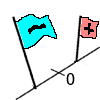 Passive
Flags Passive
Flags
|
On the other hand,
if we say,
"going rightwards/leftwards,
or,
forwards/backwards",
we are speaking
operationally.
We are
doing
something - actively.
|
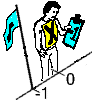 Active
Flags Active
Flags
|
So our flags are
also used twice, like the numbers: they can be both
passive signs
and active
operators.
So, for example, when we multiply, we operate,
and when, operating, we multiply minus by minus,
we are simply issuing the command, "Reverse! Go
the other way round! Stop what you're doing,
and do the opposite!" We
were "going
left", or whatever the second minus meant, before,
so on multiplying by the first minus, we will be
"going right", or positively, after. Minus
times a minus is a plus. So simple, so
easy to forget!
By this flagging scheme,
neither zero nor infinity carries a flag--both
are unsigned.
Both mark a place where transition may
be made from the section with one sign
to the section with the other. Indeed, their
roles may be swapped. If we are to
leave "plus territory" and enter "minus
territory", or vice versa, we may
do so
only by way of one of these two places
(this serves as a reminder that one point
does not divide a line; two do).
|
 |
Please do notice also that the numbers, as
quantities,
are always either zero, or
more than zero,
never less. They simply cannot be less.
|
|
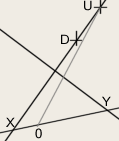
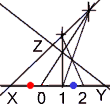
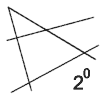
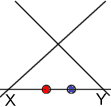
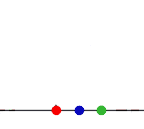
 Passive
Flags
Passive
Flags Active
Flags
Active
Flags